#Herbig–Haro object
Explore tagged Tumblr posts
Text

Herbig–Haro object - Skylar over at instagram - described it at the link below.
instagram
8 notes
·
View notes
Text
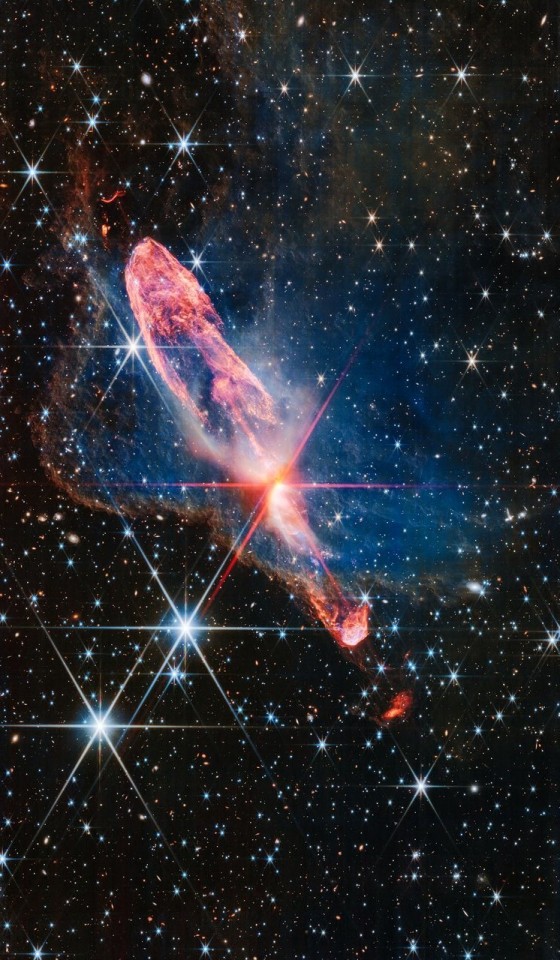
Forming Stellar Duo
280 notes
·
View notes
Text

"Webb peeks into Perseus" and the reflection nebula NGC 1333 embedded there, and sees 'baby star jets', aka Herbig-Haro objects. NGC 1333 "is in the Perseus molecular cloud, and located approximately 960 light-years away."

Map of the Perseus molecular cloud - Wikipedia.
3 notes
·
View notes
Text
[source]

This is a fascinating cosmic scene captured by Hubble: jets firing out from the rotational poles of a newly-ignited star illuminate gas and dust inside the Orion B cloud, 1,350 light-years away, forming what's called a Herbig-Haro object.
Credit: Jason Major
947 notes
·
View notes
Text
0 notes
Text
Star-forming nebulae are busy places. Unfortunately, clouds of gas and dust usually hide the action. To cut through the dust in one such region, a team of astronomers used the Atacama Large Millimeter Array (ALMA). They peered inside the Pillars of the Carina Nebula and studied molecular outflows (or jets) emanating from objects in this famous star-birth nursery. Ph.D. student Geovanni Cortes-Rangel of the Instituto de Radioastronomía y Astrophysíca in Mexico, along with other team members from Mexico and Japan, wanted to know more about the action inside those pillars. There’s a lot going on in those pillars and in the nebula surrounding them. For one thing, a pair of massive star clusters dominates the region. Trumpler 14 and Trumpler 16 contain dozens of hot young O-type stars that are emitting huge amounts of ionizing ultraviolet radiation.
0 notes
Text
James Webb Space Telescope captures stunning images of actively forming stars
James Webb Space Telescope captures stunning images of actively forming stars
James Webb Space Telescope captures stunning images of actively forming stars. The James Webb Space Telescope has captured a stunning new image of two actively forming stars, collectively known as Herbig-Haro 46/47. The image shows the stars embedded in a disc of gas and dust, about 1,400 light-years away from Earth. James Webb Space Telescope has just captured a new image of actively forming…
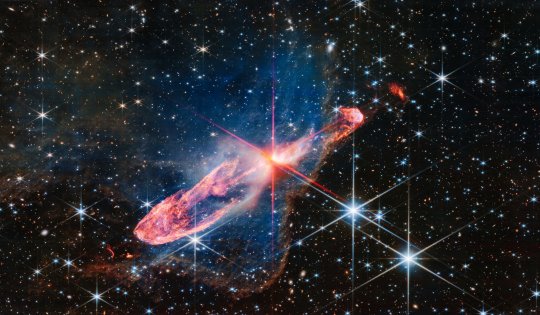
View On WordPress
#000 years old#1#100#400 light-years away#accreting#amazing images#bow shock#Herbig-Haro 46/47#Herbig-Haro object#James Webb Space Telescope#natal cocoon#Near-Infrared Camera (NIRCam)#power of JWST#revolutionize our understanding of star formation#star formation#stunning image
1 note
·
View note
Text
[source]

Hubble Sees New Star Proclaiming Presence with Cosmic Lightshow by NASA Hubble Space Telescope
#reblog#astronomy#starbirth#fs tauri#fs tauri a#fs tauri b#multiple star#herbig-haro object#taurus-auriga region#taurus#hubble space telescope
414 notes
·
View notes
Text

HH 45
HH 45 is a region within the Running Man Nebula, which is part of the larger Orion Molecular Cloud Complex.
The Running Man Nebula, also known as NGC 1977, is a reflection nebula located in the constellation Orion. It gets its name from its appearance, which resembles a running figure.
HH 45 specifically refers to a Herbig-Haro object, which is a type of astronomical object formed by the interaction of a young stellar object (like a protostar) with the surrounding gas and dust.
Credits: NASA, ESA, and J. Bally (University of Colorado at Boulder); Processing: Gladys Kober (NASA/Catholic University of America)
#nebula#space#constellations#astronomy#galaxy#stars#cosmos#nasa#hubble#space exploration#astrophotography#universe#outer space#astro observations#space photography#aesthetic
205 notes
·
View notes
Text
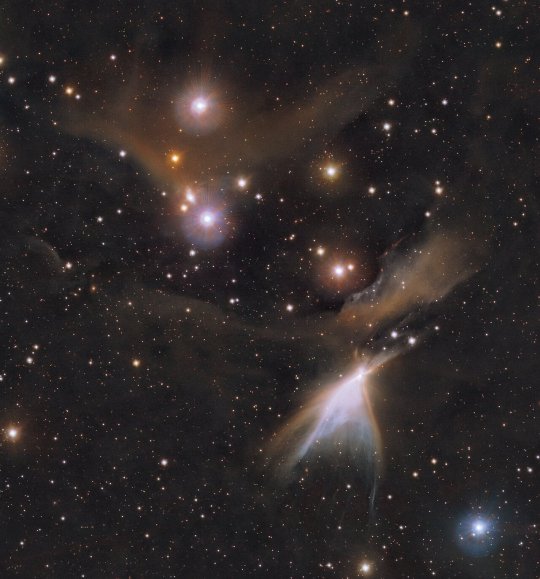
Infrared Nebula
115 notes
·
View notes
Text
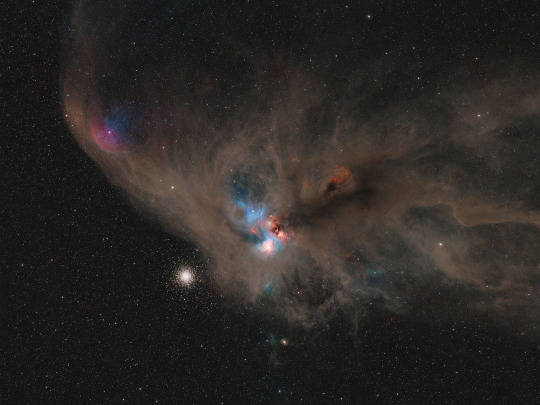




Reflection nebulae NGC 6727 and NGC 6726, with Herbig-Haro objects (baby star jets) and other nearby deep space objects, including variable nebula NGC 6729, and IC 4812, all in Corona Australis, the 'Southern Crown.' 1. and 2. Photo and detail by Mark James Ford. 3. Photo by Mark Hanson. 4. Annotated photo by Mark Hanson. 5. Annotated photo by Josep M. Drudis (Astrodrudis).
#Mark James Ford#Mark Hanson#Josep M Drudis#Astrodrudis#astrophotography#Corona Australis#NGC 6726#NGC 6727#NGC 6729#IC 4812#Herbig-Haro objects#protostars#cosmic skies & clouds
3 notes
·
View notes
Text



Can you find the question mark?



#reblog#astronomy#james webb space telescope#hh 46/47#herbig-haro objects#protostsrs#star formation#vela#merging galaxies#?#question mark
167 notes
·
View notes
Text
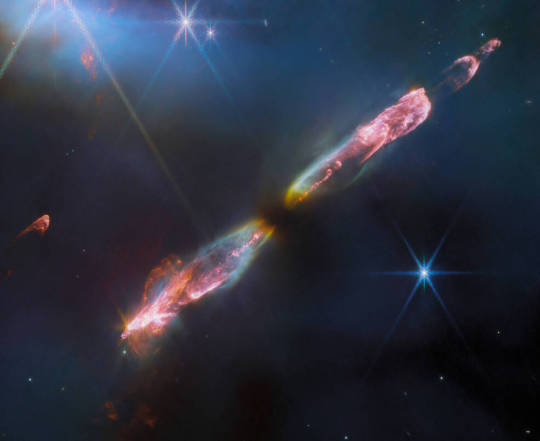
NASA’s James Webb Space Telescope’s high resolution, near-infrared look at Herbig-Haro 211 reveals exquisite detail of the outflow of a young star, an infantile analogue of our Sun. Herbig-Haro objects are formed when stellar winds or jets of gas spewing from newborn stars form shock waves colliding with nearby gas and dust at high speeds.
Credits: ESA/Webb, NASA, CSA, T. Ray (Dublin Institute for Advanced Studies)
3K notes
·
View notes
Photo

Lynds Dark Nebula 1251, 2024-06-22
Stars are forming in Lynds Dark Nebula (LDN) 1251. About 1,000 light-years away and drifting above the plane of our Milky Way galaxy, LDN 1251 is also less appetizingly known as "The Rotten Fish Nebula." The dusty molecular cloud is part of a complex of dark nebulae mapped toward the Cepheus flare region. Across the spectrum, astronomical explorations of the obscuring interstellar clouds reveal energetic shocks and outflows associated with newborn stars, including the telltale reddish glow from scattered Herbig-Haro objects hiding in the image. Distant background galaxies also lurk in the scene, almost buried behind the dusty expanse. This alluring view spans over four full moons on the sky, or 35 light-years at the estimated distance of LDN 1251.
Credits: NASA's 'Astronomy Picture Of The Day.'
42 notes
·
View notes
Text
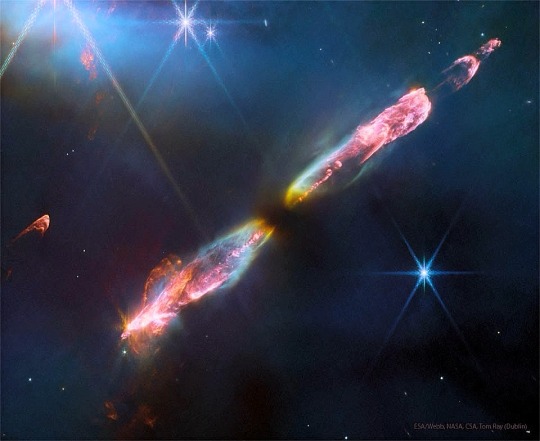
SPACEMAS DAY 4 ✨🪐🌎☄️☀️🌕
Do stars always create jets as they form? No one is sure. As a gas cloud gravitationally contracts, it forms a disk that can spin too fast to continue contracting into a protostar. Theorists hypothesize that this spin can be slowed by expelling jets. This speculation coincides with known Herbig-Haro (HH) objects, young stellar objects seen to emit jets. Pictured is Herbig-Haro (HH) 211, a young star in formation recently imaged by the James Webb Space Telescope (JWST) in infrared light and in great detail. Along with the two narrow beams of particles, red shock waves can be seen. The jets of HH 211 will likely change shape as they brighten and fade over the next 100,000 years, as research into the details of star formation continues.
Image Credit: ESA/NASA, JWST
#astronomy#space#science#universe#spacemas#day 4#star#formation#jets#spin#interstellar#interstellar gas#gravity#star formation#colours#infrared#shock waves#follow#like#reblog#the first star#the first starr#thefirststar#thefirststarr#nasa#apod#tumblr#blog#hh object#herbig haro 211
82 notes
·
View notes
Text
(source: 1, 2)

Celestial Lightsaber
#reblog#apod#astronomy#hh 24#astronomical jets#herbig-haro object#star formation#orion molecular cloud complex#orion#star wars#hubble space telescope
98 notes
·
View notes